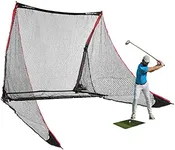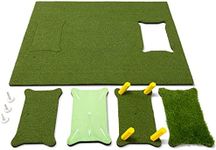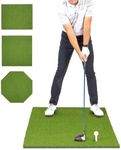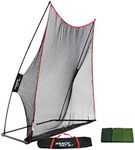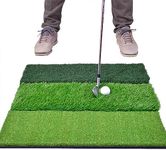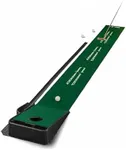Buying Guide for the Best Golf Mats
Choosing the right golf mat is important for both beginners and experienced golfers who want to practice their swing at home or in a training facility. A good golf mat can help you simulate real course conditions, protect your clubs, and provide a comfortable and safe surface for repeated practice. When picking a golf mat, it's important to consider how and where you'll use it, how realistic you want the feel to be, and how much space you have available. Understanding the key features will help you find a mat that matches your practice needs and helps you improve your game.Material QualityMaterial quality refers to what the mat is made from, such as nylon, polypropylene, or rubber backing. This is important because higher-quality materials last longer, feel more like real grass, and are gentler on your clubs and joints. Mats made from premium materials tend to resist wear and tear, while cheaper mats may wear out quickly or feel too hard. If you plan to practice often, look for mats with a thick, durable surface and a solid base. For occasional use, a lighter mat may be sufficient.
Turf ThicknessTurf thickness is the height and density of the artificial grass on the mat. Thicker turf feels more like hitting off real fairway grass and provides better shock absorption, which is easier on your wrists and elbows. Thin mats may feel hard and can cause discomfort or even injury over time. If you want a realistic practice experience or have sensitive joints, choose a mat with thicker, denser turf. For basic chipping or putting practice, a thinner mat may be enough.
Size and ShapeThe size and shape of the mat determine how much space you have to stand and swing. Larger mats allow you to practice with a full stance and even move around, while smaller mats are more portable and fit in tight spaces. If you have a dedicated practice area, a larger mat is ideal for full swings and comfort. If you need to store the mat easily or use it in different locations, a smaller or foldable mat may be more practical.
Base PaddingBase padding is the layer underneath the turf that provides cushioning and stability. Good padding helps absorb the impact of your swing, protects your joints, and prevents the mat from sliding around. Mats with thick, non-slip bases are safer and more comfortable, especially for frequent or intense practice. If you practice indoors or on hard surfaces, prioritize mats with extra padding. For outdoor use on grass, less padding may be acceptable.
Tee CompatibilityTee compatibility means whether the mat allows you to use real tees, built-in rubber tees, or both. This is important if you want to practice drives or use different clubs. Some mats have holes for inserting real tees, while others only work with fixed rubber tees. If you want the flexibility to use your own tees and practice with different heights, look for mats with real tee compatibility. If you only plan to practice irons or chipping, this may be less important.
PortabilityPortability refers to how easy it is to move, store, or transport the mat. Lightweight mats or those that roll or fold up are easier to carry and store, making them ideal for people with limited space or who want to practice in different locations. Heavier, more solid mats are better for permanent setups but can be difficult to move. Consider how often you'll need to move the mat and choose one that matches your lifestyle.


